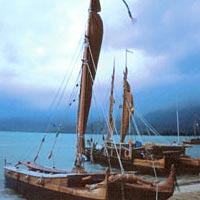 |
usa | world | animals | vocabulary | health | science | math | history |
Polynesians
Archaeological and linguistic evidence suggests that the first Polynesians entered the Tongan islands sometime around 1800 B.C., bringing with them the Lapita culture which originated in the Santa Cruz Islands.
The early Polynesians were skillful navigators, capable, by careful observations of cloud reflections and bird flight patterns, to determine the existence and location of islands. Archaeological evidence indicates that by about 700 A.D., every inhabitable island in the vast triangle of Polynesia had been colonized. By comparison, Viking navigators first settled Iceland around 175 years later.
The discovery of new islands and island groups was by means of entire small villages of people setting sail on great Polynesian catamarans. While the early Polynesians were skilled navigators, most evidence indicates that their primary exploratory motivation was to ease the demands of burgeoning populations. Polynesian mythology does not speak of explorers bent on conquest of new territories, but rather of heroic discoverers of new lands for the benefit of those who voyaged with them.

While further influxes of immigrants from other Polynesian islands sometimes augmented the growth and development of the local population, for the most part, each island or island group's culture developed in isolation. There was no widespread inter-island group communication, nor is there much indication during this period of any interest in such communications, at least not for economic reasons. This fact makes all the more astounding the limited linguistic entropy of the Polynesian languages.
During the period following complete settlement of Polynesia, each local population developed politically in diverse ways, from fully-developed kingdoms in some islands and island groups, to constantly-warring tribes or extended family groups between various sections of islands, or in some cases, even within the same valleys on various islands.
While it is likely that population pressures caused tensions between various groups, the primary force that seems to have driven unity or division among tribes and family groups is geophysical: on low islands, where communications are essentially unimpeded, there does not appear to have developed any widely-observable incidence of conflict. At the same time, there were often warring groups inhabiting such low islands, even those on various islands in the same atoll. Meanwhile, on most high islands, there were, historically, warring groups inhabiting various districts, usually delimited primarily by mountain ridges, with carefully drawn lowland boundaries. Early on, however, many such islands developed a united social and political structure, usually under the leadership of a strong monarch. The most glaring exception to this high-island theme is in the Marquesas Islands, where warring groups continued to massacre members of enemy tribes well into the 19th century. The interesting thing about the Marquesas Islands exception is that, unlike other high-island groups in Polynesia, the Marquesas are not surrounded by fringing coral reefs, and consequently, have no low coastal plains. Every valley in the Marquesas is accessible to other valleys only via boat, or by travelling over steep mountain ridges. Rather than undermining the thesis then, that political unity was a direct outgrowth of geophysical conditions, the example of the Marquesas in fact confirms it.
The first Polynesian islands visited by European explorers were the Marquesas Islands, first discovered by Europeans when the Spanish navigator, Álvaro de Mendaña de Neira, found the islands in 1595.
Because of the paucity of mineral or gemological resources, the exploration of Polynesia by European navigators (whose primary interest was economic), was of little more than passing interest. The great navigator Captain James Cook was the first to attempt to explore as much of Polynesia as possible.
Following the initial European contacts with Polynesia, a great number of changes occurred within Polynesian culture, mostly as a result of colonization by European powers, the introduction of a large number of alien diseases to which the Polynesians had no immunity, slaving ventures to supply plantations in South America, and an influx of Christian missionaries, many of whom regarded the Polynesians as descendants of the lost tribes of Israel. In many cases, colonizing powers, usually under pressure from missionary elements, forcibly suppressed native cultural expression, including the use of the native Polynesian languages.

Following World War II, political change came more slowly to the islands of Polynesia than to the other parts of overseas colonies of European powers. Although sovereignty was granted by royal proclamation to New Zealand as early as 1907, this did not go into full effect until 1947.
Independence and/or increasing autonomy is not the only influence affecting modern Polynesian society. The primary driving forces are, in fact, the ever-increasing accessibility of the islands to outside influences, through improved air communications as well as through vastly improved telecommunications capabilities. The economic importance of tourism has also had a tremendous impact on the direction of the development of the various island societies. Accessibility of outside sources, as well as the tourism viability of individual islands has played an important role to which the modern culture has adapted itself to accommodating the interests of outsiders, as opposed to the influences of those intent upon promoting the retention of native traditions. Because of this, Polynesia is today an area in varying degrees of extreme cultural flux.
This article is licensed under the GNU Free Documentation License. It uses material from the Wikipedia article "Polynesia".